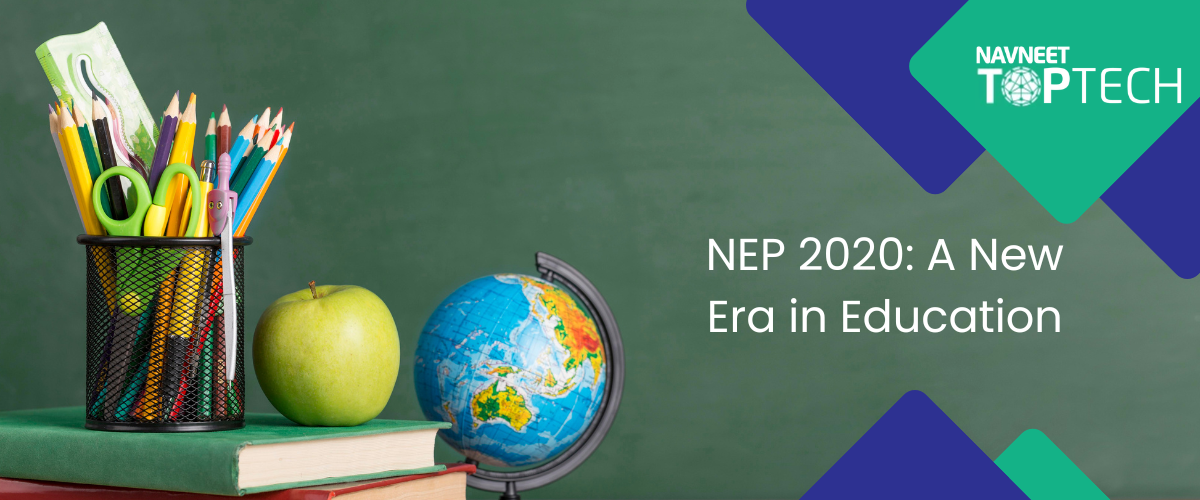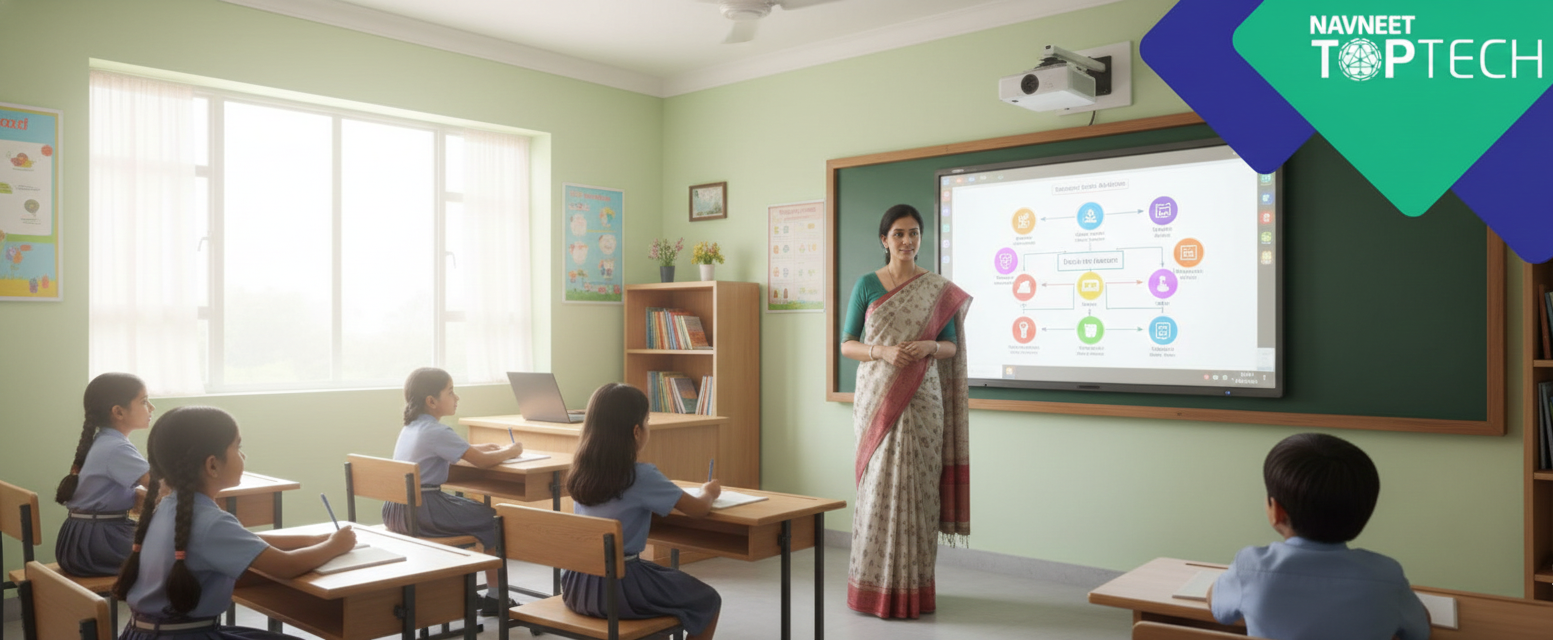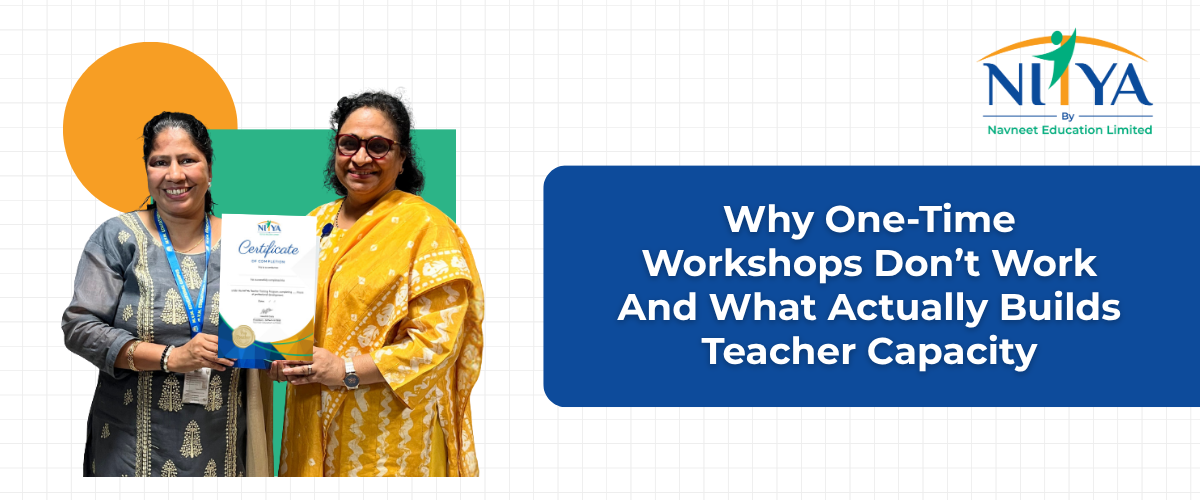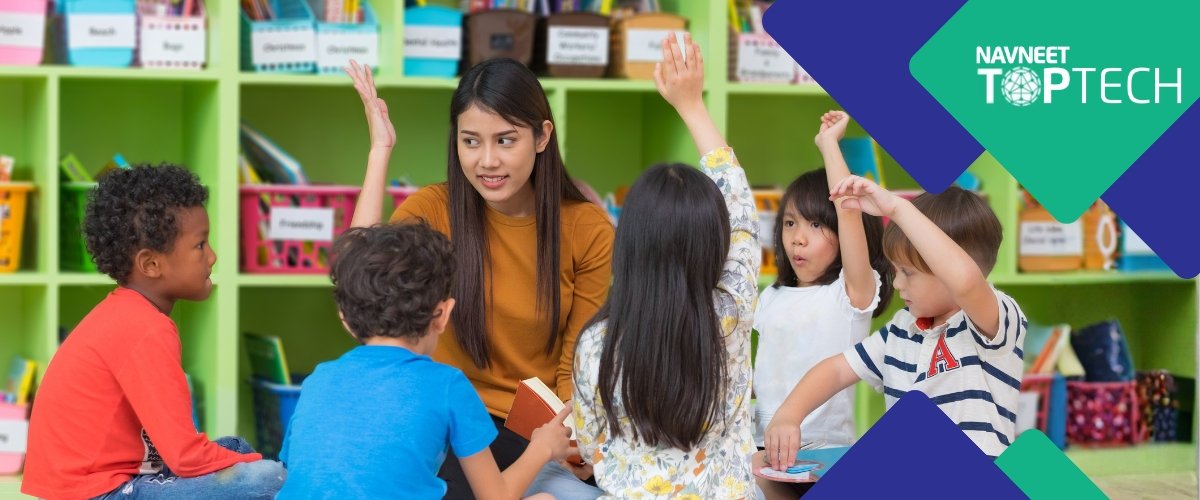Key Takeaways
- Introduces a new 5+3+3+4 education structure, replacing the old 10+2 system.
- Promotes multilingual learning with the mother tongue till Class 5.
- Focuses on holistic, skill-based education instead of rote learning.
- Adds vocational subjects from Class 6 and mandates a 4-year B.Ed with annual CPD.
- Pushes digital and data-driven learning through NETF and edtech initiatives.
NEP 2020 in India: The National Education Policy 2020 marks a historic transformation in India’s education system. Replacing the 1986 policy, NEP 2020 brings a host of game-changing features and highlights aimed at making education more inclusive, flexible, skill-based, and future-ready.
In this blog, explore the key features of NEP 2020, its impact on schools, and how school leaders can implement these reforms effectively.
What is NEP 2020? | National Education Policy 2020 Explained
Approved by the Union Cabinet on July 29, 2020, the National Education Policy 2020 replaced the earlier National Policy on Education 1986. It is a forward-looking education policy with the following at its core:
The NEP 2020 aims to foster critical thinking and creativity, boost digital literacy, and ensure inclusive education at all levels, from pre-primary to higher education.
To explore the complete and official version of the policy, you can read the NEP 2020 document shared by the Ministry of Education
Key Structural Changes in NEP 2020
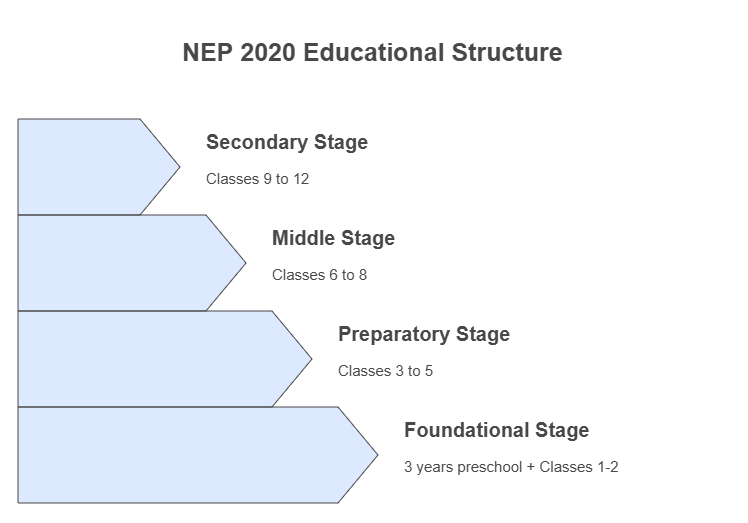
As an overview, the NEP 2020 replaced the existing 10+2 educational structure with a brand-new 5+3+3+4 system. In simple terms, these numbers reflect children’s cognitive development stages.
In a nutshell, this shift translates to:
- Stronger foundational literacy and numeracy
- Multidisciplinary education
- Flexible learning paths
- Integration of vocational training in the learning structure
Structural Changes in New Education Policy 2020: The 5+3+3+4 Model
One of the most talked-about features of New Education Policy 2020 is the new 5+3+3+4 system, replacing the older 10+2 model. This structure reflects a learner’s developmental stage:
- Foundational Stage (5 years): 3 years of preschool + Classes 1–2
- Preparatory Stage (3 years): Classes 3–5
- Middle Stage (3 years): Classes 6–8
- Secondary Stage (4 years): Classes 9–12
Apart from this system, the ECCE (Early Childhood Care and Education) is also at the heart of the National Education Policy 2020. It is focused on ensuring that children aged between 3 years to 8 years in age receive quality education early on in life.
For all stakeholders in the schooling ecosystem, this requires them to collaborate closely with pre-primary educators and Anganwadi systems. Moreover, the NEP 2020 has quite a few guidelines that have a direct impact on schools and educational institutions.
So, let’s take a look at these policy highlights.
Top NEP 2020 Highlights for Schools
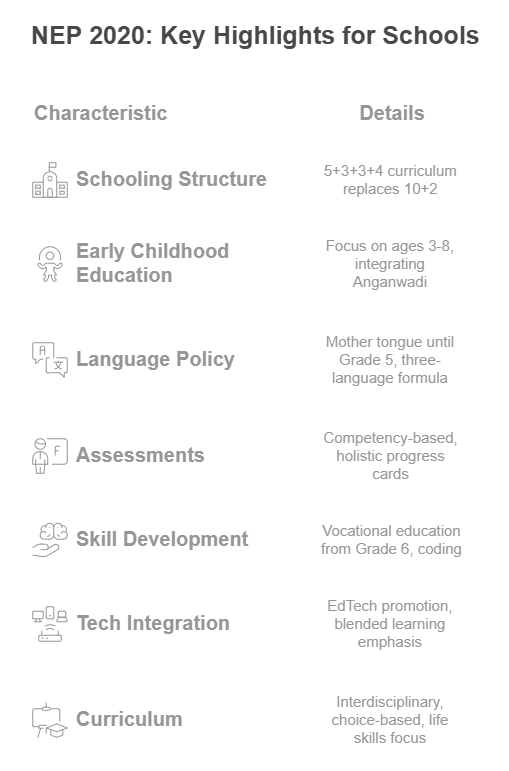
The NEP 2020 is aimed at bringing about positive transformation in our country’s education system. Hence, it requires cooperation from school leaders too. Here are some things that the NEP 2020 requires schools to focus on:
- Reducing the content overload and ensuring a flexible curriculum at school.
- Shifting away from too much theory to move towards experiential and skill-based learning.
- Renewing emphasis on the ethical and socio-emotional development of every student.
- Introducing vocational education right from Class 6th.
Now, let’s dig deeper into these changes!
Curriculum Features of New Education Policy 2020
- NEP 2020 wants schools to eliminate rote memorization and prioritize competency in their curriculum.
- It also directs schools to focus on multilingualism.
- The policy also emphasizes the importance of integrating arts and sports into the curriculum.
- Schools shall also promote environmental education.
- The students must be taught vital 21st-century skills such as problem–solving, digital literacy, and critical thinking.
Educators must redesign teaching methods, assessments, and learning materials to align with this approach.
Holistic Assessment Reforms
- The NEP 2020 shifts away from the ‘only grades matter’ mode of student assessment. Instead, it encourages schools to focus on a complete assessment of students’ capabilities, creativity, and character with holistic progress reports.
- As a result, teachers have to focus on conceptual clarity rather than marks scored.
- Student self-assessment and peer review are also championed to make the assessment multi-dimensional.
- Schools must track learning outcomes rather than depending entirely on grades to asses a student.
These reforms are aimed at crafting personalized learning pathways for students and giving practical meaning to the phrase, “Every child is special”.
To implement these reforms, digital tools offered by NAVNEET TOPTECH can help schools implement a holistic and automated student assessment system (more on the same, later).
Language Policy: NEP 2020 and Multilingualism
- The traditional three-language formula will continue to be followed. The mother tongue or the regional language will be prioritized, at least till class 5.
- However, the policy also requires teachers to be equipped with the skills and awareness necessary to handle multilingual classrooms. Here’s where multilingual content backed by technology comes to the fore, featuring interactive learning modules and more.
How School Leaders Can Implement NEP 2020 Effectively
For administrators, senior academics, and headmasters, NEP 2020 has clearly outlined several areas of focus. These include:
- Recreating the learning environment provided to students to make it as free and encouraging as possible.
- Training and upskilling teachers who are highly capable.
- Ensuring inclusive learning spaces and making education and learning resources accessible to all.
- Replacing the rush for grades and rote learning with a culture of innovation and continued improvement.
Now, let’s elaborate a little on the educator recruitment and training aspect of the NEP 2020.
Guidelines for Teachers & Training Requirements
For teachers, NEP 2020 guidelines include:
- A minimum 4-year integrated B.Ed becomes the standard qualification for teachers.
- All teachers must participate in 50 hours of Continuous Professional Development (CPD) annually, which they can do via programs like NITYA.
- Performance-based career progression must be ensured for teachers at all levels.
Technology & NEP 2020: The Push for Digital Learning
Digital learning and encouraging digital literacy are at the core of the NEP 2020. Some key directives within the policy for digitization include:
- Introduction of the National Education Technology Forum (NETF), which will work as an autonomous body to provide evidence-backed advice to Central and State Government agencies on tech-based interventions in education.
- Digitization of academic curriculum and study material for students.
- Adaptive and interactive learning platforms in schools.
- Real-time and in-depth tracking of student performance.
In this regard, NAVNEET TOPTECH provides just the answer with a multi-featured LMS (Learning Management System) for schools that offers:
- Digital Smart Classroom Solutions for Schools.
- Interactive learning tools for digitized and engaging learning sessions.
- Online student attendance assessment and monitoring.
- Digitized lesson planning that aligns with the National Education Policy 2020.
To learn more, explore NAVNEET TOPTECH’s digital classroom solutions that are in line with NEP 2020.
NEP 2020: Opportunities for School Leaders
For schools and educational institutions in India, NEP 2020 offers exciting opportunities to:
- Develop future-ready educational institutions and embrace inclusive learning.
- Opt for solutions like NAVNEET TOPTECH for complete NEP 2020 compliance.
- Empower students as well as teachers.
- Build robust parent-school-community ecosystems.
By staying informed and opting for innovation in education, schools can turn the game-changing NEP 2020 into real-life results.
How NAVNEET TOPTECH Supports New Education Policy 2020 Goals
NAVNEET TOPTECH boasts a comprehensive suite of tools that meet the NEP 2020 guidelines.
- Digital content that aligns with the curriculum is available in a diverse set of Indian languages.
- A teacher training program that aligns with the National Education Policy 2020.
- Tools for real-time student assessment and performance tracking.
- An online student attendance monitoring system that integrates seamlessly with different modes of teaching.
- Digital smart class software and hardware solutions.
These solutions by NAVNEET TOPTECH not only ensure that your school complies with NEP 2020 but also promote interactive learning, academic excellence, operational efficiency, and enhanced student-teacher-parent collaboration.
Want to know how it can all happen for your school? Learn more about NAVNEET TOPTECH’s digital solutions for schools!
Frequently Asked Questions
1. What is the 5+3+3+4 system in NEP 2020?
It is the new school structure: 5 years of the foundational stage, 3 years of the preparatory stage, 3 years of the middle stage, and 4 years of the secondary stage.
2. How is NEP 2020 different from the old 10+2 system?
Unlike the old system that focused on rote learning, NEP 2020 promotes flexibility, skill-based learning, and overall student development.
3. How will NEP 2020 benefit students?
Students gain 21st-century skills like problem-solving, creativity, and digital literacy, with flexible learning paths instead of rigid streams.
4. Which earlier policy does NEP 2020 replace?
NEP 2020 replaces the National Policy on Education (NPE), 1986, which was in place for more than three decades.
5. When was NEP 2020 approved by the Union Cabinet?
The Union Cabinet approved the National Education Policy 2020 on 29th July 2020.
6. The new education structure under NEP 2020 is based on which model?
NEP 2020 follows the 5+3+3+4 model, designed around a child’s cognitive development stages, replacing the old 10+2 structure.
7. What are the main highlights of NEP 2020?
The NEP 2020 highlights India’s shift toward a flexible, skill-based, and multidisciplinary education system, emphasizing early childhood care, mother-tongue instruction, and the innovative 5+3+3+4 school structure.
8. What are the main stages of education under NEP 2020?
NEP 2020 introduces a 5+3+3+4 structure, dividing schooling into four stages Foundational (ages 3-8), Preparatory (8-11), Middle (11-14), and Secondary (14-18) – to support holistic and age-appropriate learning.

